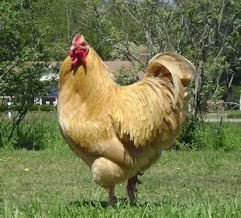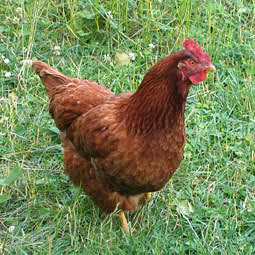Heritage Chicken Breeds
Heritage Chicken Breeds History

Buff Orpington
Chickens and their eggs are a main part of the American diet. Since making their first appearance with Spanish explorers we’ve seen breeds developed specifically for enhanced meat and egg production.
In 1873, the American Poultry Association published chicken breeds defined by the Standard of Perfection. The standard breeds defined adapted easily to production outdoors, in different climates. These early birds, or Heritage Chickens, were long-lived, hearty breeds with their reproduction a protein source for America’s growing population until the middle 1900’s.
When chickens became industrialized between 1940 and 1960, the Heritage breeds were less prominent. Hybrid breeds, with their ready from chick to table in 8 weeks, became dominant to satisfy public demand. Today, many Heritage breeds face extinction with more than 3 dozen on the Livestock Conservancy’s endangered list.
Heritage Chicken Breeds Standards

Rhode Island Red
The Livestock Conservancy issues strict guidelines for breeds defined and marketed as Heritage Chickens and they must meet all set forth standards to qualify.
- A Heritage Breed comes from an American Poultry Association Standard Breed, both parent and grandparent stock.
- Naturally mated through breed pairs of both parent and grandparent.
- Genetic ability for a long and vigorous life, thriving in pasture-based production.
Heritage Chickens must have a slow growth rate, with market weight taking a minimum of 16 weeks.
More of What Makes Heritage Chicken Breeds
Heritage Chicken guidelines also state labels must include the breed name and variety. This rule includes terms like old-time, antique, heirloom, and old-fashioned—all synonymous with Heritage Chickens.
Chickens hatched from Heritage Eggs must come from Heritage Standard Breeds recognized by the American Poultry Association and established before the mid-20th century.
15 Better Known Heritage Chicken Breeds
| Breed | Characteristics |
|---|---|
| Araucana | A much desired breed and often mistaken for the Easter Egger, this chicken lays blue eggs. Bred in the United States in the 1970's, they are scarce due to genetic breeding challenges. |
| Barred Plymouth Rock | Being slightly heavier than the Rhode Island Red makes this a favorite roasting breed. This bird is also prized for its supply of large brown eggs. |
| Black Australorp | Known as a good layer, the Australorp is also prized for its dressed weight as a meat chicken. |
| Black Minorca | A great free ranging bird, the Minorca is a non-setter, heavy bodied, and lays large, chalky white eggs. |
| Blue Andalusian | A prolific layer of large white eggs, this aristocratic bird was developed in Andalucia, Spain. They are blue, black, white, or blackwhite, but only the blue are accepted by the APA. |
| Buff Orpington | A popular farm chicken in the late 1800's to early 1900's, this bird is still prized for its excellent egg production and tasty meat. |
| Dominique | Also called the pioneer's chicken, this breed came west with American settlers. They are a medium size chicken that lays a good supply of brown eggs. |
| New Hampshire | This breed is derived from the Rhode Island Red, but is a better meat chicken than an egg layer. |
| Rhode Island Red | The star of the Heritage Breeds, this chicken is the most popular dual purpose bird. A heavy breed, they are the best layers of large brown eggs and make good broiler chickens. |
| Silver Campine | Even though this chicken is used mainly as a show chicken, they are as valued for their steady supply of white eggs as they are for their beauty. They are a very active, alert, and intelligent bird. |
| Single Comb Brown Leghorn | These hardy, non-sitters, lay large-extra large white eggs at an average of 280-300 eggs per year. |
| Speckled Sussex | This is a wonderful show bird as well as being great for meat. The Sussex was imported from England as a meat bird over 100 years ago. In addition to being prized for their meat, they are good layers of light brown or tinted brown eggs. |
| White Crested Black Polish | Lavishly plumed with rich color and lustrous sheen, the Black Polish are productive layers of white eggs. |
| White Jersey Giant | Normally raised for meat, this large bird matures slower than other meat breeds but eventually weighs the heaviest. Disease resistant. |
| White Lanshan | This statuesque breed is a good forager and prolific layer of white eggs. They are a hardy breed, fast growing, and easy to raise. |
David Kearbey says:
I’m looking to buy ISA chicks (pullets) would like to order around 75 chicks first of April
Can I get info on if and how to go about doing this
Nancy says:
Hi David,
If you want to buy locally, I suggest finding a farm supply store, or some place like Tractor Supply or Atwoods if there is no local feed store. For online purchases, my favorite sites are My Pet Chicken, Murray McMurray Hatchery, Murray McMurray Hatchery.
Neil Armitage says:
I like the variety that comes with heritage types. All chickens are characters but i prefer the fancy birds